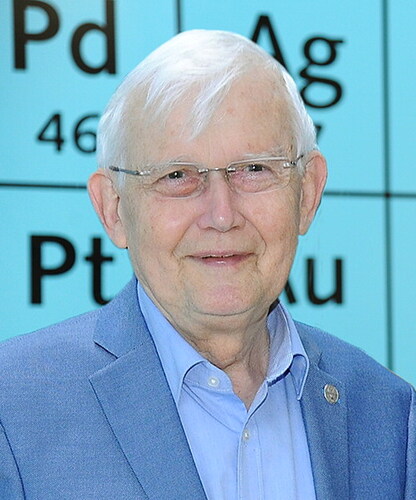On 2 January 2024, Gottfried Münzenberg passed away in Greifswald, Germany. He was an outstanding person and scientist who guided the fortunes of nuclear physics at the Society for Heavy Ion Research (GSI) for many years, shaping the scientific and instrumental portfolio and the reputation of GSI in the international research landscape. He had a major influence on various areas of modern nuclear physics, from very light exotic to super-heavy nuclei, from basic science to applications.
Gottfried Münzenberg was born in Nordhausen in 1940. After his physics studies at the Justus Liebig University in Giessen, Germany, and the Leopold Franzens University in Innsbruck, Austria, he laid the ion-optical foundation for the SHIP velocity filter, which still today is in operation at GSI for the synthesis and study of superheavy elements. He led the experiments to discover the new elements Bohrium (1981), Hassium (1984), and Meitnerium (1982), which made GSI a prominent player in the worldwide discovery race of new chemical elements, and he was codiscoverer of ground-state proton radioactivity (1982).
During the SIS-ESR upgrade of GSI, he was appointed head of the newly founded projectile fragment separator group in 1984 and developed the physical-technical concept with international participation. This enabled the experiment program with relativistic exotic nuclear beams, which from the beginning also included experiments on mass and decay measurements with exotic nuclei in the experimental storage ring. He quickly recognized the scientific and medical potential of relativistic nuclear beams and initiated the collaboration with colleagues from Dresden-Rossendorf to develop in-beam positron emission tomography. He was codiscoverer of the doubly magic nuclei 100Sn (1994),78Ni (1995), and the proton halo in 8B (1995). The discovery of more than 220 new isotopes and more than 350 new mass measurements are closely associated with his name. He gave countless lectures at international conferences and workshops. His favorite topic was the combination of nuclear physics research with instrumental developments, especially in connection with ion optics.
Gottfried Münzenberg was a member of many international advisory and steering committees, a member of the Nuclear Physics European Collaboration Committee (NuPECC) Megascience Forum, and various NuPECC working groups in the 1990s and the early years of the new millennium. He played a key role for the NuPECC report on the second-generation Radioactive Nuclear Beam Facilities in Europe, published in 2000. The physics objectives and main options outlined in the report laid the basis for the next-generation European in-flight facility and its major instrumentation, which later emerged as a prominent part of the Facility for Antiproton and Ion Research. One of his favorite future instruments was an ion-electron (A,e) collider for the study of nuclear charge distributions, giant resonances, magnetic excitations and fission of radioactive nuclei at well-defined energy and momentum transfer. He contributed significantly to the design of the scientific program for the super-conducting fragment separator and the foundation of the NUSTAR Collaboration.
Gottfried Münzenberg was also a trailblazer for many international collaborations: he triggered and promoted a wide range of individual and institutional collaborations in Germany, Europe, and worldwide. Even during the Cold War, he fostered scientific exchange and collaboration with colleagues in Dubna, Poland, Czechoslovakia, and Romania. He was a valuable advisor and well-respected partner for theorists and experimentalists. He also maintained special links with collaboration partners at RIKEN in Japan, IMP in China, and Manipal University in India.
His scientific oeuvre has been recognized, with numerous national and international high-ranking awards and honors. He has been an honorary doctor of the Joint Institute for Nuclear Research in Dubna, Russia, and an honorary doctor of the University of Jyväskylä, Finland. He received the Golden Medal of the Faculty of Mathematics and Physics of the Comenius University in Bratislava, the SUNAMCO Medal of IUPAP (together with the SHIP group and the FRS group), the Lise Meitner Prize of the European Physical Society (together with Yuri Oganessian and Peter Armbruster), and the Honorary Medal of the Hellenic Nuclear Physics Society, to name just a few representative awards of excellence.
Gottfried Münzenberg was much more than just a colleague. We have lost an outstanding person, scientist, and friend. We will remember him for his wisdom, warmth, and friendship. His repartee was legendary, his rate of speaking uncatchable, his wit was great and always refreshing, many of his spontaneous and incredibly funny and humorous comments—often quoted today and in the future—will remain unforgettable.

